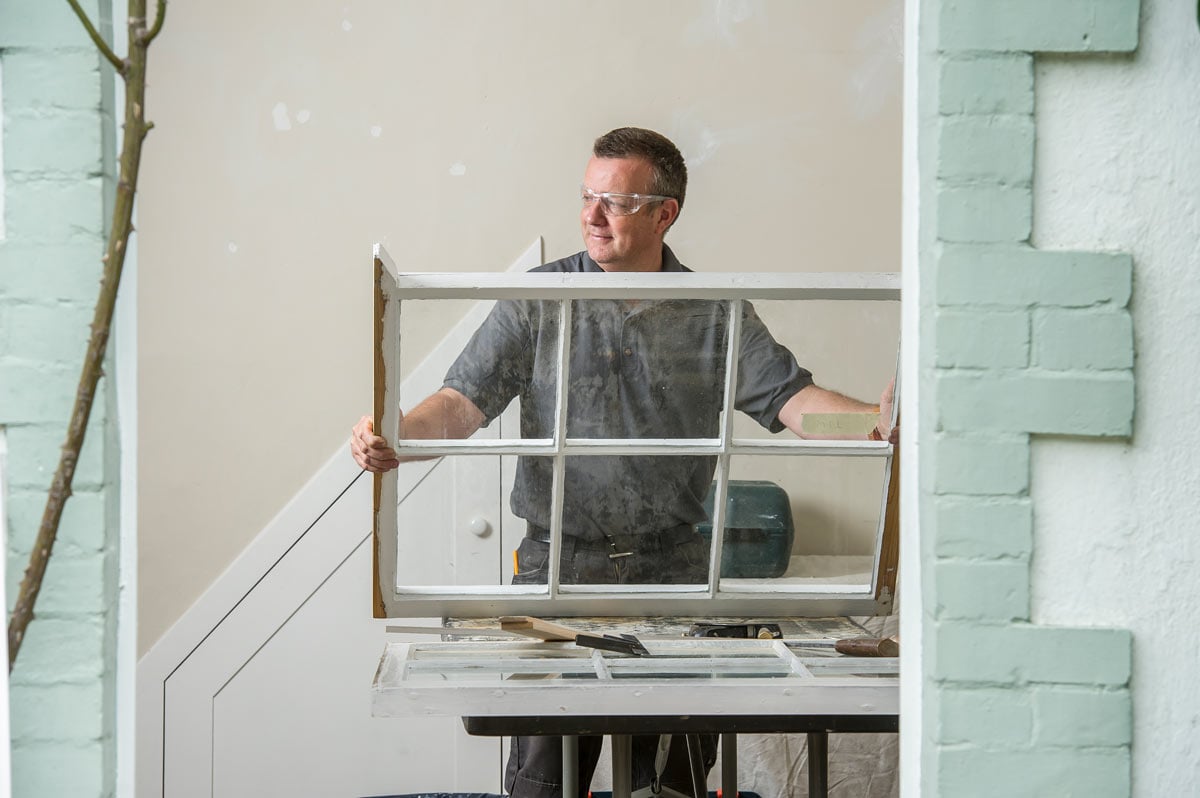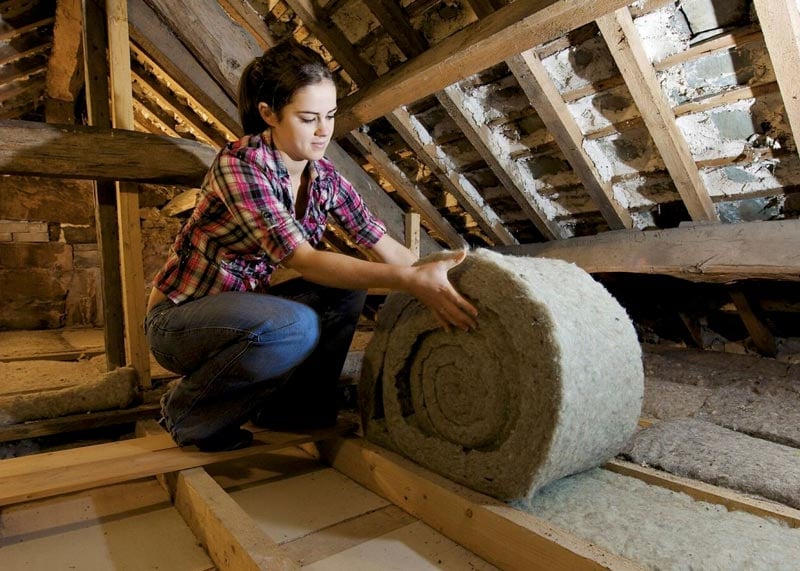At Mitchell & Dickinson, we understand the unique challenges of improving thermal efficiency in period and listed homes. That’s why we offer two tailored approaches using cutting-edge vacuum glazing technology.
Two ways to benefit from vacuum glazing:
1. Retrofitting vacuum glazing into your existing windows
Our skilled craftspeople can retrofit FINEO vacuum glazing directly into your original timber windows – providing a near-invisible upgrade that significantly reduces heat loss while preserving the charm of your historic frames.
If the timber has sufficient depth, we modify the rebates and restore the frames at the same time, often extending their life by 50 years. Draught-proofing is also included as part of the service, ensuring beautifully efficient, traditional windows.
2. Supply and installation of new timber windows with vacuum glazing
Where windows are beyond repair or a full replacement is preferred, we offer bespoke timber windows, handcrafted using sustainable hardwood. These are crafted to match the original style of your property and offer all the benefits of modern insulation without compromising period aesthetics.

Why choose vacuum glazing?
Vacuum glazing is a next-generation insulation solution offering the same performance as triple glazing but in a slimmer profile. Each unit consists of two panes of toughened glass separated by tiny micro-pillars and sealed with a vacuum chamber. This vacuum significantly reduces thermal conductivity, improving insulation, acoustic performance and durability.
- U-value of just 0.7 W/m²K
- Ultra-slim 7.7mm profile – ideal for heritage windows
- No moisture or gas ingress – long-term performance guaranteed
- Tempered glass for added safety and longevity
Our partner: FINEO vacuum glazing
We exclusively install FINEO, a market leader in vacuum glazing technology. Their units are engineered to combine exceptional performance with minimal visual impact, making them perfect for historic Georgian, Victorian or Edwardian homes.
We chose FINEO not just for their product quality, but also for their commitment to sustainability. Over half of FINEO’s research and development budget is dedicated to developing eco-friendly innovations and greener production practices.


Our sustainability promise
At Mitchell & Dickinson, sustainability doesn’t stop at installation. When we remove old windows, we offer a dedicated recycling service to ensure materials are either responsibly recycled or thoughtfully repurposed.
Quality items such as original glass, hardware and timber are salvaged for reuse in our restoration work on heritage buildings, while materials that can’t be reused are recycled responsibly through our trusted partners. From start to finish, we handle every part of the process with care, reducing waste and protecting the environment as we restore and improve your home.

Benefits of vacuum glazing
- Aesthetically beautiful: The ultra-thin profile makes them perfect for conservation projects. Although they do have visible features embedded in the glazing that are created in the manufacturing process, which are not acceptable to some customers and conservation officers.
- Low-E glass: The sealed glass units are made with Low Emissivity (Low-E) glass which improves the energy efficiency of buildings by reducing heat transfer. In cold climates, Low-E glass helps to keep the interior warm by reflecting heat back into the building, while in warmer climates, it helps to keep the interior cool by reflecting heat away from the building.
- High return on investment: Retrofitting the original windows in your listed or period property with vacuum glazing significantly reduces heat loss, meaning lower energy bills.
- Increased warmth: Comfort with exceptional thermal performance, insulation properties to (centre-pane U-values of up to 0.7 W/m²k)and superior G-values.
- Reduced condensation: Because vacuum glazing minimises heat transfer between the interior and exterior surfaces of the glass, it helps to reduce the formation of condensation on the interior surface during cold weather. The high vacuum interspace effectively eliminates dew condensation, while the outstanding thermal insulation performance keeps the interior glass surface free of condensation.
- Noise reduction: Vacuum glazing has a positive soundproofing effect against medium and low frequency noise such as traffic and construction noise. It offers good acoustic performance, without the need for thicker, heavier panes of glass.
- Reliability: Vacuum glazing units come with a warranty and an anticipated lifespan of over 25 years.
- Sustainability: Units are fully recyclable and have no noble gasses which are energy intensive to produce.
- Improved EPC rating: Installing vacuum glazing in your listed or period property will improve its energy efficiency and thus its EPC rating.
Where we can install vacuum glazing
We have operational teams across the South, South West and the Midlands, including London, Bath, Cornwall, Devon, Dorset, Somerset, Bristol, Gloucestershire, Monmouthshire, Worcestershire, Warwickshire, the West Midlands, Oxfordshire, Northamptonshire, Buckinghamshire, Wiltshire, Hampshire, Berkshire, Surrey and Sussex. We would be happy to arrange an initial consultation with you at your home to assess your property’s suitability for vacuum glazing.
Your vacuum glazing questions answered
Vacuum glazing has excellent U values, better than CosyGlazing, which may be an important factor if you want to improve the thermal efficiency of your listed or period property. However, most older window construction does not support the depth and weight of vacuum glazing, although it is slimmer than triple glazing. So for those with beautiful original Georgian windows with multiple panes of heritage glass, CosyGlazing remains the better option and the only practical option.
CosyGlazing is also the most eco-friendly option because to vacuum glaze Georgian style windows the original windows would probably need to be completely replaced with new timber windows. This means throwing the old windows and glazing into landfill at worst and recycling at best.
CosyGlazing will provide a vast improvement to the thermal efficiency of a listed or conservation window and will not be subject to the same rigour in listed building consent. This is because it does not involve the replacement of heritage glazing. It is also completely removable and invisible from the outside and, as such, complies with listed building requirements.
Vacuum glazing can either be retrofitted to older windows, provided the original timbers have sufficient depth and strength, or it can be fitted as part of a complete new window installation.
Yes, with expert craftsmanship and a thorough understanding of the construction of original period joinery, vacuum glazing can be retrofitted into both original sash and casement windows where there’s sufficient depth to the original timbers to bear the vacuum glazing itself.
No, vacuum glazing can be retrofitted into original windows, but only where the original timber profiles of the window have sufficient depth to receive the vacuum glazing pane. Where it cannot, new replacement windows can be made and fitted with the vacuum glazing. This would require planning permission for listed or conservation properties.
There are different vacuum glazing brands, such as Fineo, Landvac and Pilkington Spatia. They have slightly different features and benefits but all improve energy efficiency by improving the U value of your glazing.
Yes, in all cases, for new or retrofitted glazing listed building consent is required.










